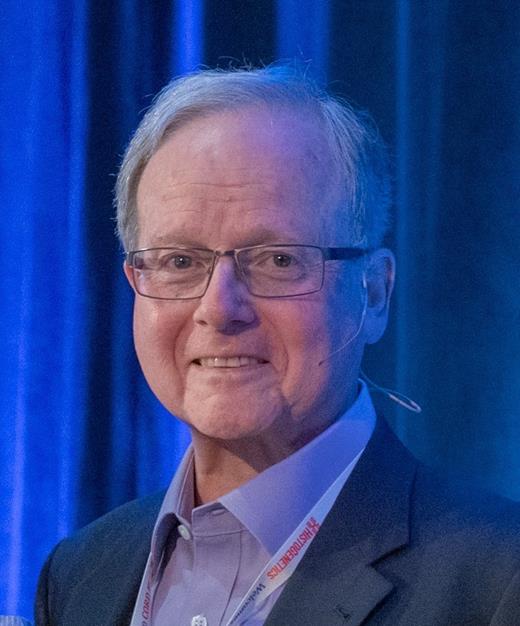Hal Broxmeyer, known to many of us as the “Father of Cord Blood Transplantation,” died on December 8, 2021, after a long and courageous battle with thyroid cancer; he was 77 years old. He was an amazing human being, a consummate mentor, and a brilliant scientist and researcher. He is survived by Beth, his wife and partner of 52 years, his sons Eric Jay Broxmeyer (and his wife Annie Owens) and Jeff Daniel Broxmeyer (and his wife Shira Roza), and his grandchildren, Naomi and Issac. Hal had an incredible life, leaving his imprint on his family and so many colleagues, trainees, and patients. He will never be forgotten.
A few weeks ago, I had the privilege of attending a celebration in honor of Hal's life held by his colleagues at the University of Indiana. For over two hours, many who knew him in his day-to-day work life shared anecdotes and memories. Repeatedly, Hal was described as an amazing leader, a caring mentor, a passionate and brilliant researcher, and a loyal friend, collaborator, and colleague. Adjectives describing Hal included smart, kind, warm, respectful, gracious, forgiving, humble, tenacious, intense, competitive, honest, and sincere. Many noted his leadership by example accompanied by his lack of arrogance and his trust, loyalty, commitment, integrity, and kindness. I was particularly touched by a younger faculty member Hal had mentored who talked about how incredibly meaningful and inspiring it was for her to hear Hal say, “I am proud of you.” She also recalled that “Hal solved everything with chocolate,” which is a great way for me to remember him.
Hal was born in Brooklyn, NY, on November 27, 1944. He was a lifelong fan of the Dodgers and loved playing stickball as a kid growing up in New York. He graduated from Lincoln High School and Brooklyn College where he excelled in track and field. He received his MS from Long Island University and his PhD from New York University (NYU) in 1966 and 1973, respectively. Hal completed his post-doctoral fellowship in 1975 at Queen's University in Kingston, Ontario, and then worked at Memorial Sloan Kettering Cancer Institute (MSKCC) from 1976 to 1983. Ron Hoffman recruited him to the IU Medical Center in 1983 where he continued to work for the rest of his life and where he served as Scientific Director of the Walther Oncology Center from 1988 to 2009.
Hal was distinguished Professor, Mary Margaret Walther Professor Emeritus, Professor of Microbiology and Immunology, and Senior Advisor to the Director of the National Cancer Institute-Designated Indiana University Simon Comprehensive Cancer Center at the IU School of Medicine. He was a prolific researcher, publishing more than 838 peer-reviewed scientific manuscripts which have been cited more than 73,000 times to date. In 2010, Hal was the first PhD to be elected president of ASH. He was also president of the International Society for Experimental Hematology and Stem Cell Research in 1991. He received numerous prestigious national and international awards during his career including the Gold Medal of the City of Paris (1993), the Karl Landsteiner Award of the American Association of Blood Banks (2002), the ASH E. Donnall Thomas Prize (2007), the Donald Metcalf Award of the International Society of Hematology and Stem Cell Research (2011), the President's Medal of Honor at Indiana University (2019), and the Lifetime Achievement Award from the Cord Blood Association (2019).
Those close to Hal knew that he loved and seriously engaged in competitive weightlifting. He competed in the Master's World Championship in 1993 and won the Master's Weightlifting National Championship in 1990 and 1994 for his age and weight division. He had an Eleiko weightlifting set in his basement, which he continued to use after he retired from competition. He also collected baseball cards, from the Brooklyn Dodgers of course.
I first met Hal in the mid-1980s when he was conducting his landmark discoveries showing that umbilical cord blood contained hematopoietic stem and progenitor cells. As he did for so many young investigators, he adopted me and encouraged me to pursue my work with umbilical cord blood. I, like several of Hal's colleagues and disciples, remember how he personally counted thousands of hematopoietic colonies during his research. His focus and attention to detail led to additional discoveries resulting from his direct observations and intense study of these colonies. This research led to the first cord blood transplant in the world on October 6, 1988, which established the field, and would not have occurred without Hal. In a truly multidisciplinary effort, Hal worked with physicians and investigators from MSKCC, the New York Blood Center, the Rockefeller University, NYU, Duke, and L’Hôpital Saint-Louis in Paris to organize the testing and collection of the cord blood, oversee its cryopreservation in his lab, and see to the recruitment of Dr. Eliane Gluckman to perform the transplant. He personally transported the cord blood to Paris on a Pan Am flight sitting next to the dry shipper (big boy) – which was allowed in those days. He subsequently developed a personal relationship that spanned three decades with Matthew, the five-year-old cord blood recipient.
Hal left an incredible legacy which has yet to be fully realized. He lives on through his family, his scientific achievements, his trainees, and his colleagues. He especially lives on through the tens of thousands of patients to whom he gave hope and whose lives were saved with cord blood transplantation. Those of us who knew Hal personally will carry his many lessons forward to continue his legacy. He made us all better than we knew we could be. We will all miss who we were in his presence and strive to be as close to that place as we can as we honor and remember him. He will be missed by all.
A fellowship has been created in Hal's honor in the Department of Microbiology and Immunology at the Indiana University School of Medicine.

